

This small article describe some revolver use by heros and vilains
of the Justice Inc. game for the Heros system.
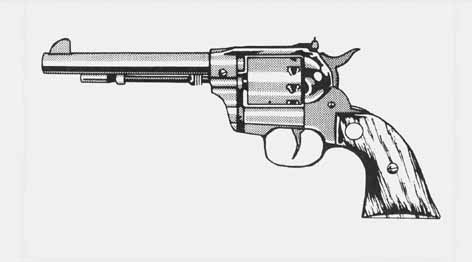 In
1873, the United States Army officially adopted the Colt to replace its
olds caplock handguns. The Colt was a tremendously powerful gun for its
time and boldly continue to be one of the most powerfull handgun in the
30. Its the legendary weapon of the cowboy who conquer the west with only
one kind of shell for both handgun (Colt) and long-gun (Winchester). A
good choice for a adventurer.
In
1873, the United States Army officially adopted the Colt to replace its
olds caplock handguns. The Colt was a tremendously powerful gun for its
time and boldly continue to be one of the most powerfull handgun in the
30. Its the legendary weapon of the cowboy who conquer the west with only
one kind of shell for both handgun (Colt) and long-gun (Winchester). A
good choice for a adventurer.
OCV: +0 R MOD: 0 DAMAGE: 1D6+1K (4DC) STUN X: 1D6 STR MIN: 12 PER
MOD: +3 SHOTS: 6 NOTES: The Buntline Colt version were made
with a longer barrel and a detachable wooden shoulder-stock. +1 R MOD with
the shoulder-stock and DAM: 1.5D6 (5DC) for the longer barrel.
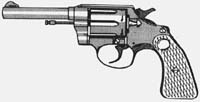 Developed
during the 1930s, the Police Positive revolver is one of the most common
police weapons in the world. its the standard handgun for a policeman or
a plain-clothe detective.
Developed
during the 1930s, the Police Positive revolver is one of the most common
police weapons in the world. its the standard handgun for a policeman or
a plain-clothe detective.
OCV: +0 R MOD: +0 DAM: 1D6+1K (4DC) STUN X: 1D6-1 STR MIN: 9 PER
MOD: +2 SHOTS: 6
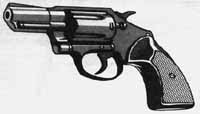 Developped
during the 1930s, the Detective Special is simply the snub-nosed version
of the Colt Police Positive revolver.
Developped
during the 1930s, the Detective Special is simply the snub-nosed version
of the Colt Police Positive revolver.
OCV: +0 R MOD: -2 DAM: 1D6+1 (4DC) STUN X: 1D6-1 STR MIN:9 PER MOD:
+1 SHOTS:6 NOTES: +1 to fast-draw
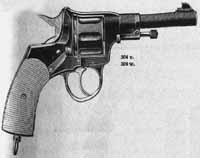 This
is a unremarkable and underpowered revolver adopted by the French governement.
This handgun is the standard French army sidearm.
This
is a unremarkable and underpowered revolver adopted by the French governement.
This handgun is the standard French army sidearm.
OCV: +0 R MOD: +0 DAM: 1D6 (3DC) STUN X: 1D6-1 STR MIN: 6 PER MOD:+2
SHOTS: 6.
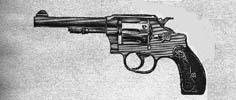 In
1902 S&W introduced a swing-out cylinder, simultaneously-ejecting revolver.
Through a bewildering number of name changes and minor variations, it remained
the most common police and security sidearm of America.
In
1902 S&W introduced a swing-out cylinder, simultaneously-ejecting revolver.
Through a bewildering number of name changes and minor variations, it remained
the most common police and security sidearm of America.
OCV:+0 R MOD:+0 DAM: 1D6+1 (4DC) STUN X: 1D6-1 STR MIN: 7 PER MOD:
+2 SHOTS: 6
 The
S&W M27 was designed in the 1930s and was the firts firearm to use
the .357 Magnum cartridge. It reigned supreme as the most powerful revolver
in the world until the 1950s.
The
S&W M27 was designed in the 1930s and was the firts firearm to use
the .357 Magnum cartridge. It reigned supreme as the most powerful revolver
in the world until the 1950s.
OCV: +1 R MOD: +0 DAM: 1.5D6 (5DC) STUN X: 1D6-1 STR MIN: 10 PER
MOD:+2 SHOTS: 6
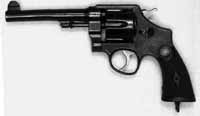 With
the involvement of the US in the WW1 came the demand for arms as the military
geared for combat abroad. As the armed forces grew, the need for suitable
arms became pressing. The existing stock s and production levels for the
Colt M1911 pistol were soon outstripped and orders were placed with S&W.
The result was the M1917 wich was simply an update of an earlier design.
In order to simplify logistics, it was chambered for the 45 ACP round (the
same round of the Colt M1911). One interesting feature of this handgun
is the use of the half moon clip. Each clip holds three rounds thus it
is easy to reload the weapon (In Hero terms one phase and not the mandatory
3 phases for a revolver).
With
the involvement of the US in the WW1 came the demand for arms as the military
geared for combat abroad. As the armed forces grew, the need for suitable
arms became pressing. The existing stock s and production levels for the
Colt M1911 pistol were soon outstripped and orders were placed with S&W.
The result was the M1917 wich was simply an update of an earlier design.
In order to simplify logistics, it was chambered for the 45 ACP round (the
same round of the Colt M1911). One interesting feature of this handgun
is the use of the half moon clip. Each clip holds three rounds thus it
is easy to reload the weapon (In Hero terms one phase and not the mandatory
3 phases for a revolver).
OCV: +1 R MOD: +0 DAM: 1D6+1 (4DC) STUN X: 1D6 STR MIN: 8 PER MOD:+2
SHOTS: 6 NOTES: SEE TEXT ABOVE.
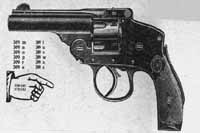 Introduced
in 1887, this was the preeminent holdout gun of the late 19th and early
20th centuries. The gun was small, with a smooth profile and no protuding
sigth or hammer. The hammer was inside the mechanism and the gun could
only be fired double-action. Its most common nickname was Lemon Squeezer;
it had a grip safety and, unless the grip was held firmly in firing position,
it would not fire. This, and the lack of an entangling hammer, made it
the most suitable sort of gun to be carried in a pocket. It could even
be fired from a pocket with little danger of jamming. Criminals favored
the gun because it was concealable, economical and anonymous.
Introduced
in 1887, this was the preeminent holdout gun of the late 19th and early
20th centuries. The gun was small, with a smooth profile and no protuding
sigth or hammer. The hammer was inside the mechanism and the gun could
only be fired double-action. Its most common nickname was Lemon Squeezer;
it had a grip safety and, unless the grip was held firmly in firing position,
it would not fire. This, and the lack of an entangling hammer, made it
the most suitable sort of gun to be carried in a pocket. It could even
be fired from a pocket with little danger of jamming. Criminals favored
the gun because it was concealable, economical and anonymous.
OCV: +0 R MOD: -1 DAMAGE: 1D6K (3DC) STUN X: 1D6-1 STR MIN: 8 PER
MOD:+1 SHOTS: 5 NOTES: +1 to fast-draw.
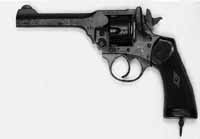 The
Webley is a good revolver design, but is not particularly remarkable. Perhaps
its most handy feature is its ability to break open, making its reloading
time faster than side-loading revolvers. (If loading it with speed-loader
"Prideaux", the reloading time is only 1/2 phases). This handgun is the
standard Britih sidearm.
The
Webley is a good revolver design, but is not particularly remarkable. Perhaps
its most handy feature is its ability to break open, making its reloading
time faster than side-loading revolvers. (If loading it with speed-loader
"Prideaux", the reloading time is only 1/2 phases). This handgun is the
standard Britih sidearm.
OCV: +1 RMOD: -1 DAM: 1D6 (3DC) STUN X: 1D6-1 STR MIN: 7 PER MOD:+2
SHOTS: 6 NOTES: SEE TEXT ABOVE.
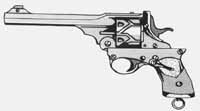 This
is a unique revolver possessing a very distinctive design. When fired,
the force of the recoil turns the cylinder automatically, making it effectively
a semi-automatic revolver. The Webley-Fosbery is also an early user of
speed-loaders. (same as the Webley).
This
is a unique revolver possessing a very distinctive design. When fired,
the force of the recoil turns the cylinder automatically, making it effectively
a semi-automatic revolver. The Webley-Fosbery is also an early user of
speed-loaders. (same as the Webley).
OCV: +1 R MOD: +0 DAM: 1D6+1 (4DC) STUN X: 1D6 STR MIN: 8 PER MOD:+3
SHOTS: 6 NOTES: SEE TEXT ABOVE.
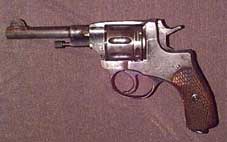 The Nagant gas-seal
revolver was patented by the Nagant brothers (Emile and Leon) in 1892 with
some additional
improvements made in 1895. This design was one of several offered to
the Imperial Russian Army as a new service revolver in
1895. Emile and Leon were on good terms with the Russian Army due to
a previous cooperative effort to produce the
Mosin-Nagant M1891 service rifle. This may be why the Russians adopted
their design.
The Nagant gas-seal
revolver was patented by the Nagant brothers (Emile and Leon) in 1892 with
some additional
improvements made in 1895. This design was one of several offered to
the Imperial Russian Army as a new service revolver in
1895. Emile and Leon were on good terms with the Russian Army due to
a previous cooperative effort to produce the
Mosin-Nagant M1891 service rifle. This may be why the Russians adopted
their design.
The first 20,000 revolvers were manufactured by the Nagants in Liege
Belgium between 1895 and 1898. In addition to
purchasing these guns the Russians bought the equipment and tooling
necessary for domestic production. The Russian "Tula"
arsenal began producing revolvers in 1898.
The revolvers purchased from Liege had single/double action lockworks.
When production began in Russia almost all revolvers
were made in single action only. This continued until the 1917 Russian
Revolution after which The Nagant was once again
primarily made in single/double action. Nagant revolver production
continued in the new USSR until at least 1945 and I can
vouch for at least one 1945 Tula made revolver that is single action
only. In addition to the standard revolver there was a short
barreled GRU model, a silenced model, and reportedly some made in .38
Special and .22 Long Rifle. The .38 and .22 Cal.
versions did not have a gas-seal mechanism.
In 1930 Charles and Maurice Nagant, sons of Leon, sold rights, machinery
and remaining parts for the Model 1895 to Poland.
Quantities of the M1895 were produced in Poland under the name Radom
Ng30 (Ng meaning Nagant). Production continued
until adoption of the Radom VIS-35, 9mm semi-auto pistol in 1935.
The Nagant revolver has poor stopping power, a long heavy double action
pull, and a loading gate and ejection rod that makes
reloading slow and cumbersome. On the plus side it's extremely reliable
and easily repaired if problems do occur. This made
them very popular with the troops. The M1895 Nagant is an interesting
piece of shooting history.
OCV: +0 RMOD:+1 DAM: 1D6(3DC) STUNX: 1D6-1 STR MIN: 6 PER MOD:+2
SHOTS: 6 NOTES: THIS REVOLVER IS ABLE TO USE A SILENCER